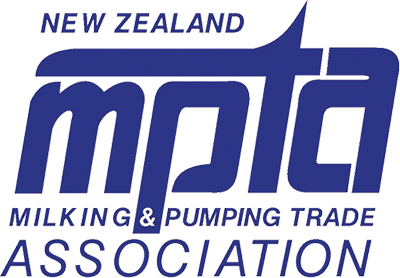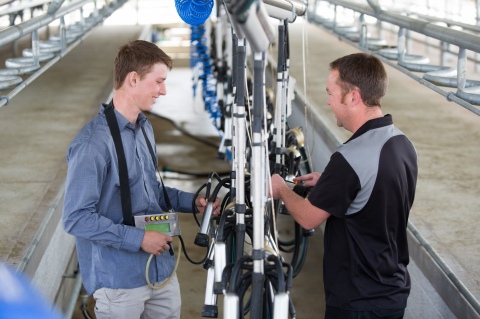ISO Milking Machine Testing
Designed to teach practical skills in both an online and a workshop like situation. It is the basis of the milking machine industries training program for new technicians and those re-entering the industry.
Course Description
As a major exporter of dairy products and equipment, New Zealand must conform closely to standards for milking machines set by the International Standards Organisation (ISO) as a basis for all milking machine manufacturers and testers.
The course has a number of pre-requisite modules that are completed online and a workshop that runs for five days comprising 10 illustrated and detailed texts or modules, each with practice exercises and skill assessment tests. Participants must complete all of the prescribed course modules. Instructions are given which enable the skilled operator to complete a module quickly or the unskilled to acquire competence. Full information is given in each module, however there are also videos, photographs, demonstration models, types of milking machines, practice with other course participants, and exercises.
Participants will gain a thorough understanding of how a milking machine should be installed and how it should operate. They will also gain the ability to test a machine for function and make recommendations on faults found. The course provides the fundamental building blocks for carrying out a Milking Machine Test and allows the Tester to test a standard milking machine using the methodology supplied. The Tester will also gain enough of a knowledge base to be better able to understand how to test machines that require more product-specific methods (but without teaching those methods) for which the Tester may need to refer to the OEM's guidelines.
Who Should Attend
Anyone involved in testing machines for function, milking machine dealer staff, sales reps, OEMs, local agents, fitters and testers, vets and advisors etc.
Click on the QCONZ PTE Enrolment Form to the right to register for this course.
Note: This course is delivered for MPTA by Quality Consultants NZ Ltd (QCONZ) - a NZQA approved Private Training Establishment.
Participants who successfully complete this course, including all the pre-course online modules and the post-course Student Workbook will receive a NZQA Micro-Credential Certificate in Milking Machine Testing.
Participants who successfully complete this course, PLUS our Farm Dairy Systems Management course will also be awarded the NZMPTA Dairy Diagnostics Specialist Endorsement.https://www.nzmpta.co.nz/course/nzmpta-dairy-diagnostics-specialist-endorsement
All course fees must be paid prior to course attendance.
Course Content
Participants will learn: visual examination of plant, using an airflow meter to carry out static testing of vacuum levels and component air use and leakage, using a pulsator recorder to test pulsation, measuring vacuum pump performance, vacuum regulation and milk pump performance, completing test reports and more.
On completion of the course participants wishing to become registered as a Milking Machine Tester must accurately test six milking machines in the field and have tests marked, and accepted by an independent, industry recognised marker. Test reports should be emailed to [email protected] or posted to MPTA, P O Box 10514, Te Rapa, Hamilton 3241
A electronic version of the Milking Machine Testing Manual and the NZ Milking Machine Testing Standards Manual are issued to the participants to keep for future reference.
Practising Certificate
On completion of all course requirements a NZMPTA Registered ISO Milking Machine Tester Practising Certificate will be issued (additional charge $150-00 + gst).
The Practicing Certificate will expire after two years and will be re-issued upon submitting six correct Test Reports to the NZMPTA for independent marking.
Registered Testers found guilty of malpractice may have their Practicing Certificate withdrawn.
Venue
NZMPTA Technology Training Centre
BID6, 2 Batchelar Road
Turitea
Palmerston North (Fitzherbert Science Park)
Additional Information
- Facilitator Quality Consultants New Zealand Ltd (QCONZ) on contract to the NZMPTA.
- Pre-Course Work Participants are required to complete pre-course modules online. Instructions on how to access the pre-course introductory modules will be issued approx. four weeks prior to the course commencement. These modules, which involve approx. 10-12 hours of study, MUST be completed within one week of the course commencement. Failure to complete the pre-course modules may result in enrolment being cancelled.
- Course times commence at 10.00am on the Monday and will finish approx 4.00pm on the following Friday. Usual daily attendance is required from 8.00am to 5.00pm on the days in-between.
- Accommodation can be arranged at a nearby Motel for approx. $135.00 / night. Accommodation must be paid in full directly to the accommodation provider.
Technical Basis
The course is based on ISO Standards 3918, 6690 and 5707. Some modifications to these have been necessary because milking pipeline systems rather than recorder jar systems are the norm in Australasia.
The principal variations from the ISO standards are:
- Testing system spelled out in detail and practical considerations included, e.g. ‘permissible air leaks’
- Standards for installation included only where integral to milking machine function. (These standards are set and amended by a technical committee made up of representatives from the MPTA, QCONZ and the various Research organisations.)
- Specifically the course has been built around all the New Zealand milking machine manufacturers.
Modules
A brief introduction to what is covered in each module is listed below:
- Making and breaking physical connections in a milking machine: The various unions, connections, and clamps holding a milking machine together, all of which students must be capable of disconnecting and reconnecting.
- Identification of milking machine parts by their general name and function: The components that make up a milking machine are described to help students learn to recognise them and know their function.
- Placing parts of a milking machine In correct position relative to one another: The various configurations of milking machines (for rotary, herringbone, and walk-through sheds) are shown. Students must be capable of placing all the pipelines and components appropriately on to a layout diagram.
- Identification of milking machine parts by manufacturer, retailer, brand name, and model: Photograph albums contain colour photographs of most of the milking machine components which students must be able to recognise.
- Safety: The safety rules for working with milking machinery. Students must recall all the rules when memory-jogging titles are given.
- Disconnection and re-connection of the milking machine for a test: This module covers the series of disconnections (and re-connections) that accompany the air-flow tests. The student must be capable of correctly making all these disconnections and re-connections.
- Visual faults: The various milking machine faults which can be seen, felt, or heard without meters are discussed. The student must correctly identify 10 major visual faults in a test milking machine.
- Dismantle, clean, reassemble, and adjust regulators: Details are given on how to dismantle, clean, reassemble and adjust all types of regulator on the New Zealand market. The student must correctly clean three regulators, indicate missing parts, and show how to adjust the regulators. The student must also demonstrate an understanding of vacuum regulation characteristics.
- Assembling and starting a milking machine prior to the test: The likely disconnections and safety hazards that would prevent the milking machine from being started safely. The student must safely start a milking machine.
- Use test instruments: Operation and practical use of the air-flow meters, vacuum recorders, vacuum gauges and revolution counters. Students must correctly use all these test Instruments under specific conditions. Demonstrate how to perform additional tests not necessarily required in an ISO test.
- Follow the flow chart: The milking machine testing system has been written down as a flow chart with detailed notes. Students must correctly follow the flow chart.
- Testing a milking machine: This module covers the test itself. Students must be able to carry out a full test on any type of milking machine.
- Introduction to the basic mechanics of the milking machine: The concepts of vacuum and air flows as they affect milking machine operation. The student must correctly interpret what will happen in given situations.
- Understand pulsation and calculating the pulsation test results: The analysis of pulsation graphs. The student must correctly analyse a graph. The student must know how to identify faulty pulsation and the standards used to assess it. The student must correctly identify a faulty pulsation system and locate the area of the fault.
- Fill in the milking machine test report and note the interactions between test readings and visual faults and how to fill in the related test Report Forms. The student must correctly fill in two test reports determining the standards used in milking machine testing - the standards used are covered in detail. The student must look up and record correctly the standards for two hypothetical milking machine tests. The student must also calculate the statistics of a milking machine. These calculations are necessary to understand the results of a test. The student must correctly carry out the calculations for two hypothetical milking machine tests.
- Recommendations on the milking machine test: This module covers the recommendations and includes a flow chart to ensure all considerations are included. The student must correctly make recommendations on two hypothetical milking machine tests.



